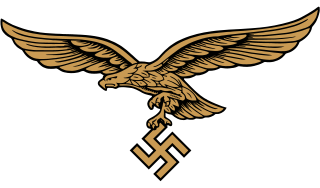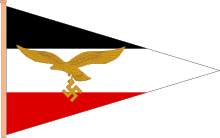The German 10th Infantry Division was created in October 1934 under the cover name Wehrgauleitung Regensburg to hide its violation of the Treaty of Versailles. It was renamed the 10th Infantry Division when the establishment of the Wehrmacht was announced publicly in October 1935.

The 3rd Infantry Division was an infantry division of the German Army that fought in World War II. The division was established under the cover name Wehrgauleitung Frankfurt in 1934 by expanding the 3rd Division of the Reichswehr. It was redesignated Kommandant von Frankfurt shortly afterward, and took on its bona fide name when the formation of the Wehrmacht was announced in October 1935. In March 1939 the division took part in the invasion and occupation of Czechoslovakia.
The German 18th Infantry Division was formed on 1 October 1934 as Infanterieführer III in Liegnitz and renamed 18. Infanterie-Division on 15 October 1935. Mobilized in August 1939 it participated in the Invasion of Poland and in 1940 in the Battle of France. After the French campaign the division was motorized and redesignated 18th Motorized Infantry Division on 1 November 1940 serving on the Eastern Front for the remainder of the war. In June 1943 the division was redesignated 18th Panzergrenadier Division.

The German 5th Infantry Division was formed in October 1934 and mobilized on 25 August 1939. The division's troops were garrisoned in Konstanz, Ulm, and Freiburg. When formed, the division consisted of the 1st, 2nd, and 3rd battalions of the 14th, 56th, and 75th Infantry Regiments, the 1st, 2nd, and 3rd Battalions of the 5th Artillery Regiment, the 1st battalion of the 41st Artillery Regiment, and assorted 5th Division support units.
Jagdfliegerführer 2 was part of Luftflotte 2, one of the primary divisions of the German Luftwaffe in World War II. It was formed 21 December 1939 in Dortmund. On 6 September 1943 the unit redesignated Jagdfliegerführer 4 and reformed again in September 1943 from Stab/Jagdfliegerführer Deutsche Bucht. The headquarters was located at Dortmund and from July 1940 in Wissant, from June 1941 at Le Touquet, and from September 1943 in Stade. The unit was disbanded in December 1943.

Luftflotte 1 was one of the primary divisions of the German Luftwaffe in World War II. It was formed 1 February 1939 from Luftwaffengruppenkommando 1 in Berlin. This Luftwaffe detachment served in Estonia, Latvia, Lithuania and Immola, Finland for air support of Axis forces in area; with command offices in Malpils, Latvia,, Eastern front.
Luftflotte 2 was one of the primary divisions of the German Luftwaffe in World War II. It was formed 1 February 1939 in Braunschweig and transferred to Italy on 15 November 1941. The Luftflotte was disbanded on 27 September 1944.
Luftflotte 3 was one of the primary divisions of the German Luftwaffe in World War II. It was formed on 1 February 1939 from Luftwaffengruppenkommando 3 in Munich and redesignated Luftwaffenkommando West on 26 September 1944. This Luftwaffe detachment was based in German-occupied areas of Northern France, the Netherlands, Belgium, and Vichy France, to support the Axis power's forces in area. Its command offices were in Paris, France.
Jagdfliegerführer Deutsche Bucht was one of the primary divisions of the German Luftwaffe in World War II. It was formed in December 1939 at Jever for the defense of the German Bight. On 1 December 1943 the unit redesignated Jagdfliegerführer 2 and subordinated to the 2. Jagddivision. The headquarters was located at Jever and from 1943 in Stade.
1st Air Division was one of the primary divisions of the German Luftwaffe in World War II.
5th Fighter Division was one of the primary divisions of the German Luftwaffe in World War II. It was formed in June 1943 and subordinated to the 12th Air Corps. The Division was reorganised as 7th Fighter Division on 15 September 1943 and reformed again the same day in Paris and subordinated to the 2nd Fighter Corps. The unit was relocated to Karlsruhe-Durlach in October 1944 and subordinated to Luftwaffenkommando West. The division was redesignated to 16th Air Division on 26 January 1945.
2nd Air Corps was formed on 11 October 1939 in Frankfurt am Main from the 2. Flieger-Division. During Operation Barbarossa and from 22 June to 12 November 1941, the Corps flew over 40,000 day and night sorties, dropping 23,150 tons of bombs and claiming 3,826 Soviet aircraft destroyed as well as 789 tanks, 614 artillery pieces, 14,339 vehicles, 240 enemy field positions, 33 bunkers, 159 trains and 304 locomotives along with relentless attacks on enemy troop concentrations and logistical choke-points.
8th Air Corps was formed 19 July 1939 in Oppeln as Fliegerführer z.b.V.. It was renamed to the 8th Air Corps on 10 November 1939. The Corps was also known as Luftwaffenkommando Schlesien between 25 January 1945 and 2 February 1945 and was merged with Luftgau-Kommando VIII on 28 April 1945 and redesignated Luftwaffenkommando VIII.
I. Fliegerkorps was formed 11 October 1939 in Cologne from the 1st Air Division. The Corps was also known as Luftwaffenkommando Don between 26 August 1942 until 17 February 1943. It was transformed to the 18th Air Division on 4 April 1945.

X. Fliegerkorps was a formation of the German Luftwaffe in World War II, which specialised in coastal operations. It was formed 2 October 1939, in Hamburg from the 10. Flieger-Division.
IX. Fliegerkorps was formed in November 1940 in Jever from the 9. Flieger-Division and was redesignated as IX. Fliegerkorps (J)—the suffix "J" stands for Jagd —on 13 November 1944. The Corps at the time was leading numerous Kampfgeschwader which were converting to fighter aircraft. The Corps was renamed again on 26 January 1945, this time to IX. (J) Fliegerkorps.

The 30th Infantry Division of the Wehrmacht was created on 1 October 1936 in Lübeck and mobilized on 26 August 1939 for the upcoming invasion of Poland. At that time, it consisted of the usual German infantry division elements: three infantry regiments of three battalions each, one three-battalion regiment of light artillery, one battalion of heavy artillery, a panzerjager (anti-tank) battalion, an aufklärungs (reconnaissance) battalion, a signals battalion, a pioneer (engineer) battalion, and divisional supply, medical, and administrative units.

The 15th Infantry Division was an infantry division formed on 1 October 1934 in Würzburg under the cover name Artillerieführer V by Nazi Germany's Army. With the announcement of German rearmament, the division was renamed on 15 October 1935. Mobilized on 25 August 1939, the division took part in the Invasion of Poland in the same year and the Battle of France in 1940. On 21 November 1940 one third of its personnel was used to create the 113th Infantry Division. The division was one of the units taking part in the Second Battle of Kharkov from February till March 1943. The division was destroyed in August 1944 during the Soviet Jassy–Kishinev Offensive. In October 1944 a new 15. Infanterie-Division was raised near Cluj-Napoca using the remainders of the old division and new recruits. On 5 May 1945 the division surrendered to the Red Army at Brod.
The German Luftwaffe of the Wehrmacht had seven Jagdfliegerschulen or Fighter Pilot Schools.
5. Flieger Division was one of the primary divisions of the German Luftwaffe in World War II. It was formed on 1 August 1938 in Braunschweig from the Höheren Fliegerkommandeur 7. The Division was redesignated 31. Flieger-Division on 1 November 1938 and was renamed to 5. Flieger Division again on 1 February 1939. The division was redesignated to V. Fliegerkorps on 11 October 1939 and reformed again on 19 December 1944.










